How environmentally friendly are Iceland’s data centers? – Part 3
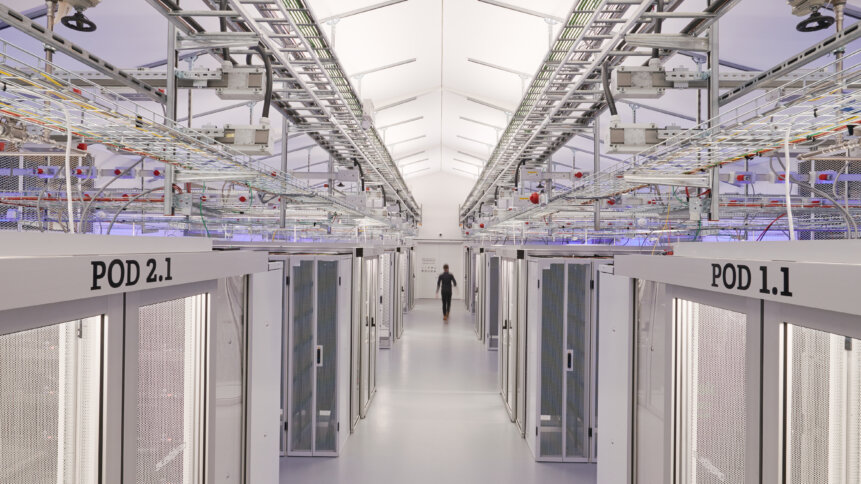
- Data centers prioritize sustainability in materials and cooling.
- Bitcoin mining is a large consumer of Iceland’s renewables.
- As data demands increase, data center heat may be repurposed.
Part 3: Data centers
It would be easy for Iceland to overlook the true environmental impact of data centers, as they make up 5.3 percent of the country’s GDP. Powered by 100 percent renewable energy, the facilities already have a good reputation. When TechHQ visited Iceland in October, we explored two of the country’s data centers, run by atNorth and Borealis, to find out how their respective expansions were impacting the environment.
atNorth has three sites in Iceland but seven overall, with the others located in Finland, Sweden, and Denmark. It has ambitions to be the largest data center operator in the Nordics and boasts one of the lowest TCOs for co-location in the world. In total, atNorth has 126 MW of capacity and offers co-location service and ‘HPC as a service’. “If a customer is not willing to invest heavily into a big stack of HPC clusters, he can tap into us,” said Jóhann Þór Jónsson, the Director of Site Selection for atNorth. “If he wants to come and do rendering for 24 hours or 12 hours, he can come and tap into it and go back again.” Jónsson added that this is useful for the film and engineering industries, but atNorth also wants to attract hyperscaler customers like AWS and Google Cloud.
ICE03, a pristine white facility set between mountains in Akureyri, opened in the summer of 2023. Its current power capacity is 12 MW, but this will likely expand as the density of its racks increases. It boasts a power usage effectiveness (PUE) of less than 1.2 and is powered primarily by geothermal energy. It also takes some energy from the Kárahnjúkar Hydropower Plant in the east.
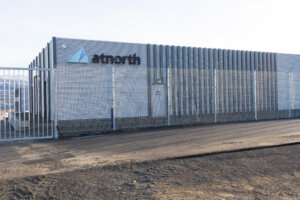
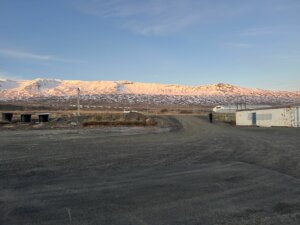
atNorth’s ICE03 (top), a pristine white facility set between some mountains in Akureyri, (bottom) only opened in the summer of this year. Its current power capacity is 12 MW, but this will likely expand as the density of its racks increases. Source: atNorth/TechHQ
Borealis manages three data centers in Iceland, with capacities of 10, 12, and 50 MW respectively. Its Blönduós facility, situated on a plain where wild horses roam, has a view of the mouth of the river Blanda. Blönduós is its smallest facility but has 10 MW of expandability. Powered by the Blanda hydropower station, it focuses on mission-critical systems like central banking and utilities that cannot be interrupted, as well as high-performance computing, AI, and disaster recovery solutions. The latter has seen increased interest from prospective and existing customers since the Russian invasion of Ukraine.
The environmental impact – cool or uncool?
Natural cooling means that Icelandic data centers use between 24 and 31 percent less energy than equivalent sites in the UK or USA, according to atNorth. However, both data center providers try to go beyond just leveraging Iceland’s ecological advantages to be environmentally friendly. István Végh-Sigurvinsson is the Sustainability Officer at Borealis and, at the Datacenter Forum, said it is his responsibility to choose vendors for hardware, cooling, and other electrical infrastructure “that are on the sustainability journey, at least” to maintain the company’s environmental standards.
The frame of atNorth’s ICE03 is built from ‘glulam’ timber instead of steel, as it is better for the environment, more fire resistant, and better absorbs seismic activity. The panels are made of steel but insulated with Icelandic rock wool, which is also fire-resistant. Having strong materials to protect the facilities is important on an island situated directly on the mid-Atlantic ridge with 33 active volcanic systems.
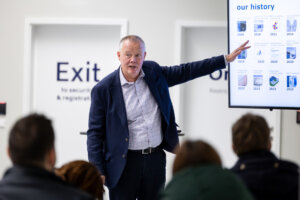
Jóhann Þór Jónsson, the Director of Site Selection, believes that atNorth will eventually transition to 100 percent direct liquid cooling. “The HPC, the AI, machine learning, it is growing at that pace,” he said. “The pace that the density is growing is so high.” Source: atNorth
“We have a lot to offer when it comes to data center security, even though we are a volcanic island,” said Mr Björn Brynjúlfsson, the CEO of Borealis. “We are just accustomed to them. We have frequent earthquakes, but they are small.” Reykjavik is the sixth-best market for political stability, fourth for sustainability, and fifth for power cost, according to the 2023 Global Data Center Market Comparison report. However, it is not one of the top 11 markets for low environmental risk, with Dublin, Madrid, and Oslo taking the top three spots.
During a presentation at Borealis’ ‘B52’ data center at Blönduós, Mr Brynjúlfsson presented a drone image of the facility and several wild horses grazing in the surrounding pastures. “We’re still sort of working in harmony with the environment,” he said, suggesting that the proximity of the animals exemplifies this. How the industry uses Iceland’s wild and powerful environment to market the country as a “natural” home for data centers has been criticized.
There are concerns about the discrepancy between the marketed image of Iceland’s suitability for data centers due to its natural elements, like cold climate and renewable energy, and the extent of the actual technological interventions required behind the scenes for efficient data center operations. The extensive development could have broader ecological impacts on the country’s wildlife which companies are less transparent about.
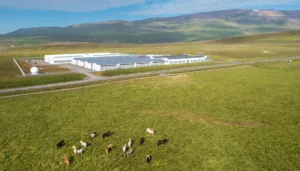
During a presentation at Borealis’ ‘B52’ data center at Blönduós, Mr Brynjúlfsson presented a drone image of the facility and several wild horses grazing in the surrounding pastures. Source: Borealis
While the impact data centers have on the local environment is unclear, Halldór Már Sæmundsson, the Chief Commercial Officer at Borealis, said that the data center is “essentially paving the way for business in the area.” He uses the example of how Borealis built a substation connecting Blönduós to the national power transmission system. “In the 25 years before Borealis came and started operations here, no new house was built and they were actually degrading in population,” he said. “Since then, they are starting to build apartments again, people are moving to the place, all industries are picking up.”
However, some reports suggest this positivity is not shared by all Icelandic communities. Some see the relationship between Icelandic data centers and their customers as one-directional, primarily benefiting the international clientele while potentially imposing burdens on local resources and environments. In 2015, investigative journalist Jón Bjarki Magnússon found that a 7.5 MW Advania server farm was disturbing neighbors with noise pollution and only employed five Icelanders. While this was eight years ago, and atNorth, for example, now has one hundred employees in total, questions persist about the scale of benefits for local inhabitants compared to the magnitude of resource consumption and potential environmental impact caused by DC facilities.
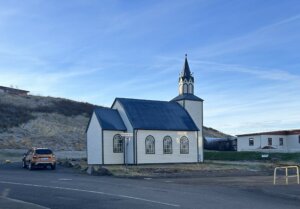
A church in Blönduós has been repurposed into a hotel room since tourists started visiting the town. The arrival of the Borealis B52 facility has helped boost the economy. Source: TechHQ
Data centers famously produce a lot of heat, and one of the most attractive elements of Iceland for hosting these facilities is the cold climate which allows for cheap and efficient cooling. Currently, both atNorth and Borealis implement direct air cooling (DAC), where cold outdoor air is allowed to flow indoors to bring down the temperature of units. Large doors around the outside of the pressurized rooms at atNorth allow the air to come in for the units to suck up. The units then blow warm air back into the room’s central area, which rises and flows out grates above the doors. There are cold air intakes on both sides of the facility which can be opened depending on which way the winds are blowing.
Borealis’ cooling system works similarly, with average highs of 55°F (12.7°C) during July in Blönduós and 23°F (-5°C) in the coldest winter months. The sides of the Borealis buildings are open, and cool air flows in through a filter. It then enters a mixing unit which combines it with internal hot air that has already been warmed by the equipment, allowing the temperature of the air blown into the room to be controlled. Direct air cooling requires very little energy and no water consumption, so it is an environmentally friendly option.
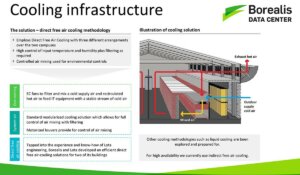
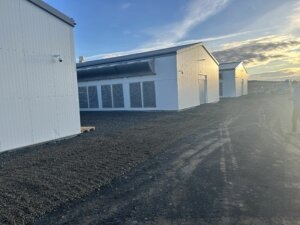
The sides of the Borealis buildings are open, and cool air flows in through a filter. It then enters a mixing unit which combines it with internal hot air that has already been warmed by the computers, allowing the temperature of the air blown into the room to be controlled. As the warm air is blown out of the mixer and circulates around the room, it heats up again, rises, and leaves through an exhaust or is returned to the mixing unit. Source: Borealis/TechHQ
Both facilities use another cooling technique: closed-loop direct liquid cooling. Hot water is cooled with outdoor air and pumped through ‘cold plates’ that sit directly on top of a component, be it a CPU, rack, or server. This is a more effective cooling method for high-density data centers as water is far more efficient at transferring heat than air and requires less ‘white space’. Mr Jónsson believes that atNorth will eventually transition to 100 percent direct liquid cooling. “The HPC, the AI, machine learning, it is growing at that pace,” he said. “The pace that the density is growing is so high.”
Mr Brynjúlfsson also said that he no longer sees “traditional racks of maybe two to three kW,” but, he surmised, this is a positive because, as rack density increases, it becomes easier to employ efficient cooling and use the heat for other purposes. In atNorth’s Swedish facility, SWE01 in Stockholm, the heat from the liquid coolant is captured and transferred to the district’s heating plant, ultimately providing a sustainable source of heat and hot water for local residents. Similar plans are in place for its newer facilities in Denmark and Norway. Borealis’ B52 currently offers both air and liquid cooling options depending on the workload required, but the company is also expecting to move towards the latter as demand for AI increases.
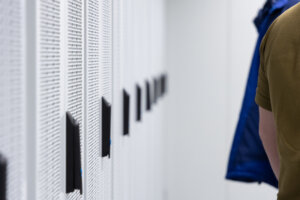
The atNorth units (pictured) currently use direct air cooling, but will likely transition to closed-loop liquid cooling as data demands increase. Source: atNorth
Direct liquid cooling of data centers with water in a cold climate like Iceland can be more environmentally friendly than direct air cooling. Water has a higher heat capacity than air, enabling more efficient heat transfer to the surrounding environment or dedicated cooling systems. Closed-loop cooling is also better than evaporative cooling, which removes gallons of water – a precious resource, despite its abundance – from the watershed.
However, direct liquid cooling with water requires the addition of a chemical coolant to stop it from freezing, and that could harm the environment if it leaked or was disposed of improperly. Furthermore, water cooling requires more sophisticated infrastructure and maintenance than air cooling, which can result in higher energy use. Direct air cooling doesn’t involve coolant, but it is less efficient. Therefore, it may require more power to maintain optimal temperatures inside the data center.
Crypto secrets
One of the most controversial aspects of Iceland’s data centers regarding their sustainability is actually who is using them. The country is a major destination for Bitcoin mining and has been since just after the cryptocurrency’s creation in 2009. Companies are tempted by the cheap renewable electricity and seemingly endless water supply, as the mining process involves concentrating lots of power, often in a small room, and producing enormous amounts of heat. Such power is necessary to verify cryptocurrency transactions and add them to the blockchain.
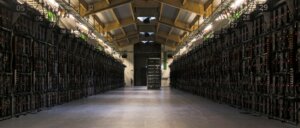
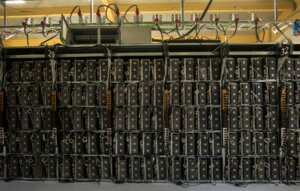
Bitcoin mining rigs inside the bitcoin factory ‘Genesis Farming’ near Reykjavik, Iceland, pictured in 2018. Source: AFP
Walking into the mining units at Borealis was an attack on the senses, the roars of the GPUs overwhelming, making the co-location racks seem like a single bumblebee in comparison. Einar Tómasson, the Head of Energy and Green Solutions at Business Iceland, said that Bitcoin miners “were important to build out the data center infrastructure” but added that the reliance on them has decreased as they tend to go out of business quickly.
The data center industry has faced criticism from conservationists who view cryptocurrency mining as wasteful of Iceland’s precious renewable resources, which should be saved for more essential services like electric cars. Petur Arason, the mayor of Blönduós where Borealis’ B52 facility is located, said: “Generally speaking, data mining has a bad reputation with our renewable energy. Some say it should not be used for data mining in Iceland in total.”
Although it is difficult to find legitimate and up-to-date figures on how much of the energy that data centers use currently goes towards cryptocurrency mining, in 2018, a report by KPMG stated that it was around 90 percent. Local experts have told the Wall Street Journal that keeping up with electricity demands fueled by the cryptocurrency industry will involve building more dams and power stations which disrupt the island’s delicate environment. But Landsvirkjun, the National Power Company of Iceland, has remarked that no power plants will be built solely to support mining activities. There are only limited plans to increase Iceland’s electricity supply with buildouts – the last geothermal station came online in 2017, and the permit for the latest hydropower plant was revoked in June.
Landsvirkjun’s head, Hörður Arnarson has said that, while melting glaciers due to global warming have boosted its hydropower generation, electricity sales were close to the maximum the company could handle. That said, the growing demand for cryptocurrency processing is still helping fuel the data center industry in Iceland, ultimately contributing to its economic growth. Any government pushback against the industry would be met with backlash from the electricity sector, which relies heavily on its top customers.
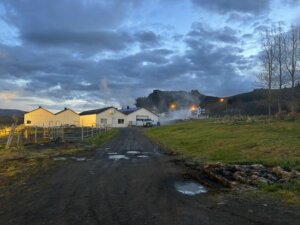
Iceland is good at diversifying its resources. As well as electricity, the geothermal power plants Hellisheiði and Nesjavellir provide more than half of the hot water used for district heating in the Reykjavík area. Drillings into geothermal fields in and around the capital are the other primary sources of hot water. Pictured: Geothermal field and geysers in the village of Varmaland, where farmers use the hot water to warm their greenhouses. Source: TechHQ
Heat of the moment
As well as electricity, the geothermal power plants Hellisheiði and Nesjavellir provide more than half of the hot water used for district heating in the Reykjavík area. Drillings into geothermal fields in and around the capital are the other primary sources of hot water, which is also used for swimming pools, snow melting, and, importantly, greenhouse cultivation. Iceland’s climate prevents the growth of many vegetables, so greenhouses reduce the need to import food.
But the geothermal reservoirs are not the only thing producing significant amounts of heat in Iceland; the data centers do, too. Some of them, like atNorth, sell their excess heat to energy companies that then distribute it to residents through the district heating plant. “There’s a long-standing know-how in Iceland on how to distribute heat over a long distance,” said Mr Jónsson.
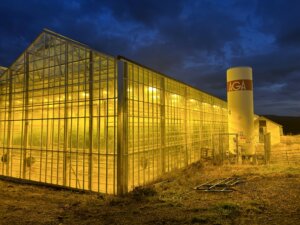

A greenhouse in the village of Varmaland growing cucumbers. Source: TechHQ
However, data center heat has many other potential uses. It can warm fish, insect, and chicken farms or be used for algae cultivation. It can also dry fruits or timber and heat greenhouses for vegetable growth. ‘Hringvarmi’ is an ag-tech startup that wants to build biomes that channel heat from data centers and use it to grow vegetables. Dr Alexandra Leeper, the company’s co-founder, said at Datacenter Forum: “In Iceland, more than 80 percent of our fresh fruits and vegetables are imported because there simply isn’t warm enough, controlled environment[s] […] for food production. In one of our environment modules, it will be possible to produce more than 3,000 kg of strawberries every year – that has a domestic market value of more than €86,000 ($94,000) and a carbon dioxide saving of nine tons per year.”
She added that cryptocurrency mining facilities are actually the best candidates to connect to Hringvarmi biomes as they have a consistent output of waste heat. Dr Leeper and her co-founder Justine Vanhalst hope that, as well as reducing the carbon footprint associated with food in Iceland, food start-ups will be able to rent out space to test if their idea has legs before scaling up.
Iceland does genuinely seem like a promising location for a sustainable data center, at least at the moment. But why are the data centers still searching for new customers if that is the case? “I think people are not aware of who we are and what we’re doing.” Eva Gubjornsdottir, the deputy CEO and CFO of atNorth, said at the Datacenter Forum. Those who believe that latency will be an issue are not considering latency non-sensitive workloads, and those who are worried about the security and safety of Iceland don’t consider that most of the internet relies on the same submarine cables that connect the country’s data centers. What’s more, all the island’s 400,000 residents depend on the cables for their communications with the rest of the world, so the network’s security is an absolute priority.
While not everyone supports the expansion of the data center industry in Iceland, with valid concerns about the impact the increasing power demands will ultimately have on the environment, the more Icelandic businesses and services host their data locally, the better off the country will be in the eventuality of a communications cut-off. Indeed, the infrastructure is expensive to build, so it is important to support the local and foreign companies that make use of it.
In pursuit of secure and sustainable connectivity, Iceland’s data centers continue to explore innovative solutions, from harnessing excess heat to leveraging the country’s renewable energy advantage. As the industry seeks broader recognition and support, its ability to bolster both local services and global connectivity remains a vital cornerstone for Iceland’s technological future.
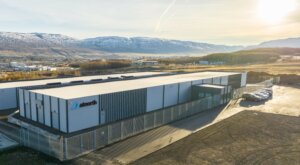
atNorth’s ‘ICE03’ data center in Akureyri. Source: atNorth
Read ‘Part 1: Demanding conditions’ here.
Read ‘Part 2: Energy and cables’ here.










